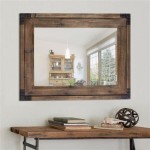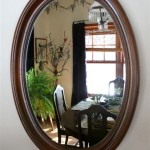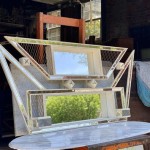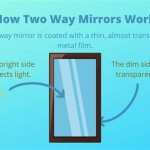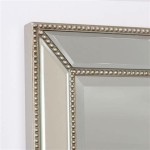Mirrored Bypass Door Hardware: Functionality, Aesthetics, and Installation Considerations
Mirrored bypass doors offer a unique blend of space-saving functionality and aesthetic enhancement for interior spaces. These doors, characterized by their sliding mechanism and reflective surfaces, are particularly useful in areas where swing space is limited, such as closets, bathrooms, or narrow hallways. The hardware components that facilitate the smooth operation and secure installation of mirrored bypass doors are crucial to their overall performance and longevity. This article explores the key aspects of mirrored bypass door hardware, focusing on their function, different types, installation considerations, and maintenance.
The primary function of mirrored bypass door hardware is to enable the doors to slide past each other, allowing access to different sections of an opening. Unlike traditional hinged doors, bypass doors do not require a swinging arc, making them ideal for confined spaces. Mirrors integrated into the door panels further contribute to the perception of spaciousness and enhanced lighting within the room. The hardware ensures that the doors glide smoothly, securely remain in their tracks, and align properly when closed. Failure of any component within the hardware system can significantly impact the functionality and aesthetic appeal of the doors.
Key Components of Mirrored Bypass Door Hardware
The hardware system for mirrored bypass doors typically consists of several essential components, each contributing to the overall operation and stability of the doors.
Track System: The track system is the foundation of the bypass door mechanism. It usually includes two parallel tracks, one for each door panel. These tracks are typically mounted to the header or frame above the door opening. The tracks are designed to guide the rollers and support the weight of the doors. The material of the track, commonly steel or aluminum, influences its durability and load-bearing capacity. High-quality track systems are designed for smooth and quiet operation, minimizing friction and noise. Some tracks may incorporate features like anti-jump mechanisms to prevent the doors from derailing.
Rollers or Hangers: Rollers, also referred to as hangers, are the components that allow the doors to move along the tracks. They are attached to the top edge of the door panel and fitted into the track. The quality of the rollers directly affects the smoothness of the door’s movement. Rollers are typically made of steel, nylon, or a combination of both. Steel rollers offer superior durability and load-bearing capacity, making them suitable for heavier mirrored doors. Nylon rollers provide quieter operation, but may have a lower weight capacity. Some rollers feature adjustable screws to fine-tune the door's alignment and ensure even weight distribution.
Guides: Guides, typically floor-mounted or track-mounted, keep the doors aligned and prevent them from swinging or swaying. Floor-mounted guides are often small, unobtrusive pieces of hardware that fit into a groove on the bottom edge of the door. Track-mounted guides, on the other hand, run within the lower track, offering a more secure and stable guidance system. The material of the guide, such as nylon or metal, affects its durability and resistance to wear and tear.
Door Stops: Door stops limit the travel of the doors and prevent them from sliding too far. They are typically installed at the ends of the track and cushion the impact of the door as it reaches its full open or closed position. Door stops help protect the doors and the surrounding frame from damage. They can be made of rubber, plastic, or metal, and are designed to absorb impact and minimize noise.
Pull Handles or Knobs: Pull handles or knobs provide a convenient way to grip and move the doors. They are typically mounted on the face of the mirrored door panels and are available in a variety of styles and finishes to complement the overall aesthetic of the room. The material of the pull handle or knob should be durable and resistant to wear and corrosion. The size and shape of the handle should be comfortable to grip and easy to use.
Factors to Consider When Selecting Mirrored Bypass Door Hardware
Selecting the appropriate hardware for mirrored bypass doors requires careful consideration of several factors to ensure optimal performance, durability, and aesthetic compatibility.
Door Weight and Size: The weight and size of the mirrored doors are critical factors in determining the appropriate hardware. Heavier doors require more robust tracks, rollers, and guides to support their weight and ensure smooth operation. The hardware's load-bearing capacity should be equal to or greater than the weight of the doors to prevent premature wear and failure. Similarly, the size of the doors influences the length of the tracks and the placement of the guides. The hardware should be appropriately sized to accommodate the dimensions of the door panels.
Track Material: The track material significantly impacts the durability and performance of the bypass door system. Steel tracks are typically more durable and offer higher load-bearing capacity, making them suitable for heavier doors. Aluminum tracks are lighter and more resistant to corrosion, but may have a lower weight capacity. The choice of track material should be based on the weight of the doors and the environmental conditions of the installation location. In humid or corrosive environments, aluminum tracks may be preferred to prevent rust and degradation.
Roller Quality: The quality of the rollers is a critical factor in ensuring smooth and quiet operation of the bypass doors. High-quality rollers are constructed with durable materials, such as steel or nylon, and feature precision bearings that minimize friction. Rollers with adjustable screws allow for fine-tuning of the door's alignment and even weight distribution. The choice of roller material should be based on the weight of the doors and the desired level of noise reduction. Steel rollers offer superior durability, while nylon rollers provide quieter operation.
Aesthetic Compatibility: The hardware should complement the overall aesthetic of the room and the mirrored doors themselves. The finish of the tracks, rollers, and pull handles should match or coordinate with the existing hardware and decor. The style of the pull handles or knobs should be consistent with the overall design of the room. Consideration should be given to the visibility of the hardware. Some homeowners prefer minimalist hardware that blends seamlessly with the doors, while others prefer more decorative hardware that adds a touch of visual interest.
Installation Complexity: Some hardware systems are easier to install than others. Consider the level of experience and expertise required for installation before making a purchase. If the installation appears complex or beyond one's capabilities, it may be advisable to hire a professional installer. Proper installation is crucial for ensuring the smooth operation and long-term durability of the bypass door system. Incorrect installation can lead to misalignment, premature wear, and even failure of the hardware components.
Installation and Maintenance of Mirrored Bypass Door Hardware
Proper installation and regular maintenance are essential for maximizing the performance and lifespan of mirrored bypass door hardware.
Installation Procedures: The installation process typically involves attaching the track system to the door frame, mounting the rollers to the doors, and installing the guides and door stops. It is crucial to follow the manufacturer's instructions carefully and to ensure that all components are properly aligned and secured. Use appropriate tools and hardware for the installation to prevent damage to the doors, frame, or hardware components. Before installation begins, verify that the door opening is square and plumb to ensure that the doors will operate smoothly. Any irregularities in the opening should be corrected before proceeding with the installation.
Alignment Adjustments: After installation, it may be necessary to make adjustments to the alignment of the doors. This can typically be done by adjusting the screws on the rollers or hangers. The goal is to ensure that the doors glide smoothly along the tracks and align properly when closed. Misalignment can cause friction, noise, and uneven wear on the hardware components. Periodically check the alignment of the doors and make adjustments as needed.
Lubrication: Regular lubrication of the rollers and tracks is essential for maintaining smooth and quiet operation. Use a silicone-based lubricant or dry lubricant to reduce friction and prevent sticking. Avoid using oil-based lubricants, as they can attract dust and debris, which can further impede the door's movement. Apply lubricant sparingly and wipe away any excess. Lubricate the rollers and tracks at least once a year, or more frequently if the doors are used heavily.
Cleaning: Clean the tracks and rollers regularly to remove dust, dirt, and debris. Use a soft cloth or brush to wipe away any accumulated grime. Avoid using abrasive cleaners or solvents, as they can damage the hardware components. Clean the mirrored surfaces of the doors with a glass cleaner to maintain their clarity and reflectivity. Regularly cleaning the hardware and doors will help prevent corrosion and extend the lifespan of the bypass door system.
Inspection and Repair: Periodically inspect the hardware for signs of wear and tear. Check for loose screws, damaged rollers, or worn-out guides. Replace any damaged or worn components promptly to prevent further damage and ensure continued smooth operation. If the doors are difficult to open or close, or if they are making excessive noise, investigate the cause and address the issue promptly. Ignoring minor problems can lead to more significant and costly repairs in the future.
Mirrored bypass door hardware plays a crucial role in the functionality and aesthetics of these space-saving doors. Choosing the right hardware, installing it correctly, and maintaining it regularly are essential for ensuring smooth operation, durability, and long-term satisfaction. By understanding the key components, factors to consider when selecting hardware, and proper maintenance procedures, homeowners can maximize the benefits of mirrored bypass doors.

Dsh 20241 Mirrored Bypass Door Track Swisco Com

23 242 72 Sliding Mirror Door Bottom Track Swisco Com

Lace Multi X Design Bypass Door Renin Closet Doors

Reliabilt Euro 48 In X 80 White Flush Mirrored Glass Prefinished Mdf Sliding Door Hardware Included The Closet Doors Department At Com

Closet Doors Renin

Reliabilt Harmony 60 In X 80 Pure White 1 Panel Mirrored Glass Prefinished Mdf Sliding Door Hardware Included The Closet Doors Department At Com

Onward 72 In Steel Bypass Door Hardware Kit 14672bc The Home Depot

Truporte 72 In X 80 Harmony White Mirror Mdf Bypass Sliding Closet Door Eu3210pwcle072080 The Home Depot

Custom Closet Doors United States Door And Mirror

23 244 48 Sliding Mirror Door Top Track Swisco Com

